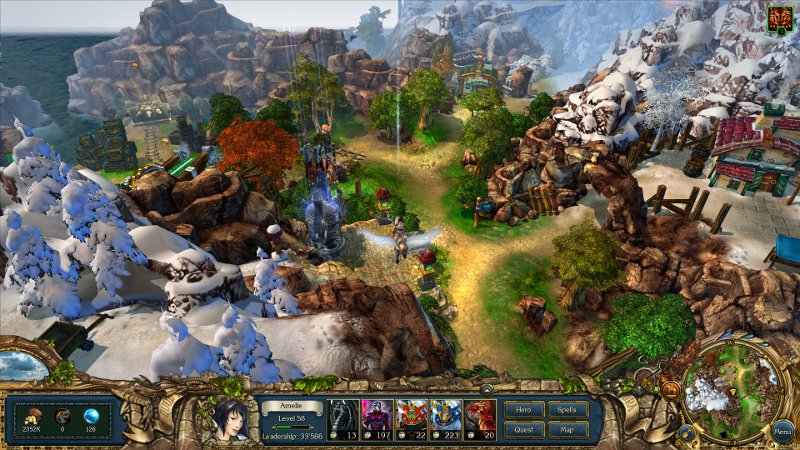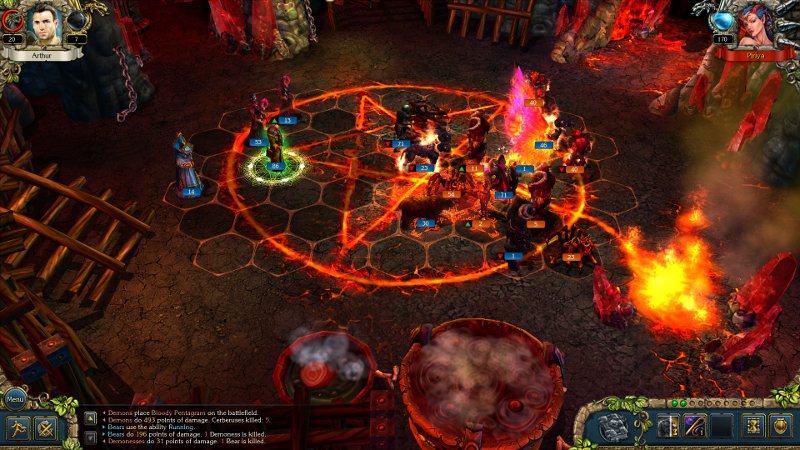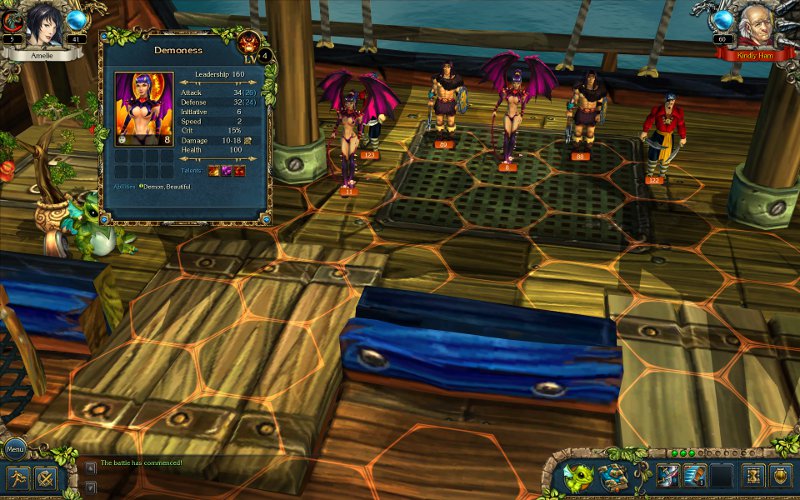Search
[{{{type}}}] {{{reason}}}
{{/data.error.root_cause}}{{{_source.title}}} {{#_source.showPrice}} {{{_source.displayPrice}}} {{/_source.showPrice}}
{{#_source.showLink}} {{/_source.showLink}} {{#_source.showDate}}{{{_source.displayDate}}}
{{/_source.showDate}}{{{_source.description}}}
{{#_source.additionalInfo}}{{#_source.additionalFields}} {{#title}} {{{label}}}: {{{title}}} {{/title}} {{/_source.additionalFields}}
{{/_source.additionalInfo}}- Details
- Category: Computer
- By Jason Gress
- Hits: 12634
King's Bounty: Crossworlds (PC)

King's Bounty: Crossworlds (PC)
Developed By: Katauri Interactive
Published By: 1C Company
Release Date: September 17, 2010
Available On: PC
Genre: Turn-based Strategy/RPG
ESRB Rating: Teen for Alcohol References, Mild Fantasy Violence, Mild Language, and Mild Suggestive Themes.
Number of Players: 1
Retail Price: $29.95
System Requirements:
* Microsoft Windows XP/Vista/7
* 2.6 GHz CPU
* 1GB RAM system memory
* NVIDIA GeForce 6600 with 128MB or equivalent ATI
* 5.5GB of free disk space
* Sound card with DirectX support
* Standalone version of Crossworlds requires King's Bounty: Armored Princess to play
Version Reviewed: 1.0.0.1, patched up to 1.3.1 with Rune Mage hotfix
(Click here to jump to the moral content)
Thanks to GamersGate for sending us King's Bounty: Crossworlds Game of the Year Edition to review!
King's Bounty: Crossworlds is the expansion pack for the popular King's Bounty: Armored Princess. King's Bounty is a tactical strategy RPG in a similar vein to Heroes of Might and Magic. The original King's Bounty for DOS actually predated Heroes of Might and Magic, and was made by the same team. Many years later, 1C Company bought the rights to the King's Bounty name, and King's Bounty: The Legend was born, with its sequel Armored Princess, and this expansion. For anyone who has played those classic games, the lineage in this game is quite apparent, and conventions established almost 20 years ago are still in use today. One notable difference is that King's Bounty has a real-time map view, instead of turn-based.
This Game of the Year edition includes four different parts. It includes Armored Princess, Orcs on the March, Defender of the Crown, and Champion of the Arena. Orcs on the March adds new content to the existing Armored Princess campaign, so there is almost no reason to play Armored Princess without the new content, as it's basically the same game. Defender of the Crown and Champion of the Arena are shorter mini campaigns, with Defender of the Crown being the shorter of the two at only around two to three hours long. The bulk of the time playing this game will be spent playing Orcs on the March, which for me was just over eighty hours, unless you spend extraordinary amounts of time working with the other new feature of the expansion: a map editor. And looking at tutorial videos online, I was very impressed.
There are two different views of the world in King's Bounty. The first is the overworld map. Each area looks like an island or arena of various sizes, which is filled with items, treasures, buildings, enemies, and the occasional NPC. As you walk around the map, you gather gold, magical artifacts, and visit buildings to gain quests and recruit the best army you can afford. There are also caves, dungeons, and other varieties of terrain to explore within an island. You may find magical scrolls, with which you can use to either cast a spell once in a pinch without mana cost, or add it to your spellbook for a more permanently available spell. There are a few spells that can be cast on the overworld map, but the vast majority of them are meant for battle.
You enter battle by walking too close to an enemy. Some enemies actively seek opponents to attack, while others are waiting for any hero brave enough to attack them. There are also battle sequences to be had by attacking fortresses, castles, or facing pirates on the open sea. Sometimes, these armies can be led by enemy heroes. These usually make for much tougher opponents. Lastly, there are boss battles that can be quite epic in scale, with many tens of thousands of hit points. When you place your mouse cursor over an enemy, the game ranks your chances for success against them, which can help determine which battles are worth fighting now, and which to save for another day.

Strong Points: Very good graphics; beautiful music; large variety of creatures; engaging hero development; fun spell system with nice spell effects; very long and engaging main campaign, along with two smaller campaigns
Weak Points: Patching process can be frustrating for the GamersGate version; the download versions require SecuROM activation with only 3 activations (though 10 deactivations are allowed); no multiplayer of any kind; quite challenging early on; substantial appropriateness issues
Moral Warnings: Fantasy violence; magic is used by the player and the enemy; many competing polytheistic world views; there is a very relativistic moral system; occult or undead is only better or worse if the player decides it is; you can offer to sell your soul to devils (and other characters have); units can be undead or even demons; occult symbols are present, and nearly unavoidable in a few circumstances; many female units, and the main hero, wears very little clothing; female allure is used as a battle tactic, along with some degrading conversations; several alcohol and one hallucinogenic reference
Once a battle begins, you are placed into a hexagonal grid of various dimensions, with the most common size being 7x9. Your army consists of up to five different types of units, of various quantities, that you have purchased or found during your journey. Your opponents vary from four to nine opponents. Each of them, like your armies, are stacks of various sizes. Each unit attacks the other and moves about the board when it is their turn, based on their speed and initiative stats. For melee attacks, in most cases the attacked party will have an opportunity to retaliate, so attacking vastly superior units is usually wrought with peril. Ranged units usually get off scot-free, though being in a melee situation with a ranged unit often doesn't turn out so well. There are many, many different special abilities that various types of units have available to them, which makes battles highly varied and exciting.
Before issuing orders to a unit, you can choose to cast a spell, or attack with your pet dragon. You can cast one spell per round. Once all units have had their turn, the next round begins. Spells cost mana, which takes time to recharge in between battles. Spells can be very powerful, and the right spell at the right place can easily turn the tide of battle. Effects range from direct damage, to powerful buffs or de-buffs, to summons, and many other effects. Magic plays a very important part in the strategy of victory in this game.
Your pet dragon does not take part in battle directly, and is not available in boss battles. During a fight, you accumulate rage as units take damage. Like mana, this is used to bring additional effects into battle, but these are only for your dragon to do. He can do things like directly damage one or more opponents, summon creatures, or gather more gold or items from the battlefield.
Your hero, Princess Amelie in three of the four campaigns, and Arthur in Champion of the Arena, can be one of three different types: Warrior, Paladin, or Mage. As you gain experience points by defeating enemies and collecting certain items around the map, you gain levels. At each level up, you gain a certain amount of leadership and talent runes. The more leadership, the more units you can control in battle. Talent runes can be spent to gain additional abilities for your hero in the skill tree, which consists of the might, mind, and magic trees. The Warrior focuses on the might tree, Paladin on the mind tree, and Mage on the magic tree. Each class has one unique skill, which the others cannot get. The Mage's higher power is the most powerful in my opinion: they can cast two spells per round.

Warriors have the most leadership, rage, attack, and defense, so they make great use of large armies, and the pet dragon. Mages have the most magic points, and a much lower leadership level, making their armies much smaller. They can dual cast and have access to some really great spells, including summons, which can definitely make up for it. Paladins are kind of a hybrid class, without the extreme strengths or weaknesses of either. A lot of their class skills are extra effective against the undead and demons. I played as a Mage most of the time. They have the best skill tree in my estimation; they are not necessarily the most powerful though, especially early in the game. When you level up, you get talent runes proportionate to your class, so while a warrior can invest points into the magic skill tree, they have many less talent runes to do so.
King's Bounty: Crossworlds is a really enjoyable adventure, with equally excellent graphics and sound. While the polygon count and such may not be cutting edge, what the game designers have done with the graphical style has made the game quite enjoyable to look at. The music is just fantastic; my wife has commented on numerous occasions how lovely the music is. Fortunately, it's all available in the game data directory as standard Ogg Vorbis files. In my opinion, music can strongly help make a game good or even great, and in this area it comes through in spades. The sound effects are also appropriately impactful. There is no voice acting; all conversations are written text.
Despite all of the great things about King's Bounty, the areas where is falters aren't really gameplay related, but significant nonetheless. GamersGate only supplies the 1.0.0.1 patch. I experienced a few crashes with this patch, though it wasn't too often. But what finally drove me to search for a patch was some of the really unbalanced gameplay problems I was having. I would fight a certain group of Orc Shamans and I would take much more damage than I ever expected. After this, I found the 1.3.1 patch online. This solved a lot of problems, but one glaring one remained: if you highlighted the 'Runic Magic' trait of the Rune Mage, the game would crash to desktop. Searching a bit more, I found the fix on 1C's forums: the Rune Mage hotfix. Ever since installing these two patches, the game has been running flawlessly, though I couldn't get it to work with the Intel graphics integrated into my i7 laptop, though I can hardly fault it for that.
What I can fault it for is the myriad of appropriateness issues. It's biggest flaw might be the skimpy clothes on most females, including the main hero, Princess Amelie. 'Armored Princess' is a bit of a misnomer; I'm not sure what armor they are talking about, because it certainly doesn't cover her legs, and if you play as a Mage, her midriff or bust area either. Which is to say there is about as much covered as your typical swimming gear. The Warrior and Paladin classes do cover a tad bit more, though it's still as curvy as possible, and the legs would still feel a draft.

Higher is better
(10/10 is perfect)
Game Score - 88%
Game Play 17/20
Graphics 9/10
Sound/Music 10/10
Stability/Polish 3/5
Controls/Interface 5/5
Morality Score - 48%
Violence 7/10
Language 6/10
Sexual Content/Nudity 2/10
Occult/Supernatural 2/10
Cultural/Moral/Ethical 7/10
Other female creatures don't fare much better. Some, like the demoness, wear what amounts to a thong, high heels, a top piece that shouldn't be seen outside of the bedroom, and carries a whip. Others, like the dryad, only have leaves covering various parts of their bodies. In addition to this, the game uses these creature's apparent beauty as a battle element – these female troops can dazzle their male enemies, which gives them a much higher chance of missing in combat. There are also a few conversation arcs where pirates ask the pretty girl to sit on their lap, or where she is referred to as the 'virgin warrior'. Fortunately, these types of conversations are rare.
If that wasn't enough, this game has quite a few occult references as well. It does them in such a way as to make them seem normal; in other words, while there is one battle arena with a large pentagram, this isn't the norm; smaller pentagrams, such as when certain characters summon demons, for example, are done without much fanfare, but they are definitely present, and can be fairly common depending on unit choice. Furthermore, while some characters do treat the demons and the undead as evil, in other cases, even necromancy is treated as though it's just the way things work. There is also one place where you can choose to bring dwarves into a certain necromancer, and once he completes his experiments, he makes available a certain undead unit, and will 'convert' others for you.
If necromancy and demons being 'normal' isn't bad enough, there is one area where a certain character has sold their soul to a devil. When you arrive to help them get it back from the demon, you also can offer to sell your own soul. And you seem pretty excited about it, too. Fortunately you can't succeed, but still... it was pretty disturbing the first time I saw this.
The game world is such that polytheism is the majority world view, and as such, considered normal. There are also cases where certain creatures are considered gods. The orcs, for example, worship a giant frog. When you defeat it, their shaman that's left explains that it was no big deal; he can raise another giant frog. Also, they believe that the world is sitting on the back of a giant turtle, an obvious allusion to similar human myths. There was also one unusual case where a doctor was being persecuted for his view on religion. This part, however, was shown in a positive light.
The main hero, Princess Amelie, is shown as being a child of the gods, and has some special purpose. Many believe that she will be able to fulfill a prophecy from their scriptures. Several spiritual types throughout the game confirm and encourage her in her quest for this reason, among others. One thing that was a little disturbing was where she inhales the fumes of a hallucinogenic plant. During this time, she goes into a strange dream state where she seems to 'remember' the gods talking about her. It's an interesting scene to be sure, but clearly hallucinogenic drugs are bad news, and anyone buying this game should be aware of an additional appropriateness issue to be aware of. Thankfully, this is not a common occurrence.
King's Bounty: Crossworlds is, in many ways, the definition of a guilty pleasure. The gameplay is quite enjoyable to me; the character, unit, and tactical depth is something that is great fun to play. The graphics and the sound are equally nice. It's a really great package from purely a gamer point of view. On the other hand, the large number of appropriateness issues, especially the female outfits and occult symbolism, are something that I try hard to avoid in video games. This is a game that is a whole lot of fun, but very difficult to recommend.








